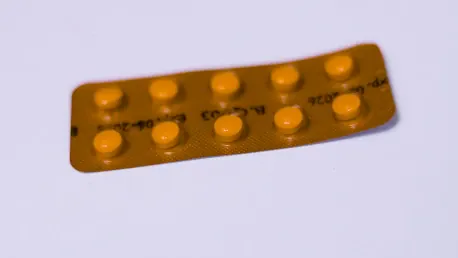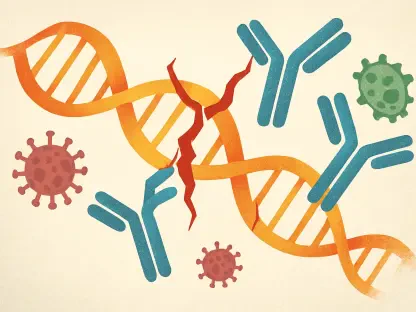The realm of medical devices is on a transformative path, markedly influenced by the integration of advanced materials like Nitinol. Known for its remarkable superelasticity, shape memory effect, and superior damping characteristics, Nitinol stands as a cornerstone in the development of innovative medical solutions. Its merger of Nickel and Titanium offers unparalleled advantages, particularly in applications necessitating precision and reliability. As healthcare demands evolve, factors such as the escalating prevalence of chronic diseases, an aging population, and technological progress in Nitinol processing are pivotal. The resulting growth in the Nitinol-based medical device market promises to be substantial, driven by a spectrum of influences that will define its future trajectory.
Market Growth Prospects
The projected growth of the Nitinol-based medical device market is set to ascend remarkably, expanding from USD 5.00 billion in 2025 to approximately USD 9.37 billion by 2034. This anticipated expansion reflects a Compound Annual Growth Rate (CAGR) of 7.23% over the forecast period. This growth is underpinned by several key catalysts, including the increasing demand for minimally invasive procedures. Nitinol’s distinct properties enable less invasive alternatives to conventional surgeries, thereby enhancing patient outcomes and driving market demand. Moreover, rising healthcare expenditures provide the necessary financial support for ongoing technological advancements and broader adoption of Nitinol-based devices.
Adding to this growth narrative are advancements in nitinol processing and manufacturing. Enhanced techniques that improve the quality and reliability of these medical devices play a critical role in their increasing acceptance and utilization. Furthermore, the adoption of nanotechnology in medical device development is an emerging trend, promising significant improvements in the functionality and efficiency of Nitinol-based devices. As the healthcare landscape continues to prioritize innovative solutions, the versatility and benefits of Nitinol will propel the market toward sustained expansion and innovation.
Regional Market Insights
North America
North America continues to dominate the Nitinol-based medical device market, primarily due to its robust healthcare infrastructure and substantial healthcare spending. The region’s well-established medical device production capabilities and commitment to healthcare innovation have cemented its leadership position. Furthermore, the prevalent aging population and high rates of chronic diseases like cardiovascular conditions foster a continuous demand for advanced medical solutions. This environment catalyzes the adoption of innovative nitinol-based devices, supporting ongoing market growth and development.
The emphasis on minimally invasive procedures within North American healthcare systems is another critical growth driver. Minimally invasive techniques reduce recovery times, minimize surgical risks, and offer enhanced therapeutic outcomes. Nitinol’s unique properties make it particularly suited for these procedures, leading to heightened demand across various medical applications. As the region’s healthcare sector advances, the integration of nitinol-based devices will remain pivotal in meeting evolving medical needs and enhancing patient care standards.
Asia Pacific
Asia Pacific is poised for the fastest growth rate in the Nitinol-based medical device market, with a forecasted CAGR of 8.06% from 2025 to 2034. The region’s rapid expansion is driven by multifaceted factors, including a burgeoning geriatric population and rising prevalence of chronic diseases. These demographic and health trends necessitate an increased focus on surgical interventions and advanced medical solutions. Countries like India play a significant role in this growth trajectory, enhancing domestic production capabilities and prioritizing improvements in patient health outcomes.
The escalating healthcare expenditures in Asia Pacific underpin the market’s expansion, providing the financial means necessary for continued investment in advanced medical devices. Additionally, the region’s increasing patient volumes for surgical procedures drive demand for innovative solutions. Nitinol-based devices, with their superior properties, are well-positioned to address these healthcare needs effectively. As Asia Pacific continues to advance its medical infrastructure and capabilities, the market for nitinol-based medical devices will experience sustained growth and innovation.
Europe
Europe is set to witness substantial growth in the Nitinol-based medical device market, propelled by its mature healthcare sector and commitment to medical device innovation. The region’s aging population and high prevalence of chronic diseases like cardiovascular conditions drive the need for advanced surgical interventions. Significant healthcare spending further supports the development and adoption of nitinol-based devices, enabling continued market expansion.
Innovation within Europe’s healthcare sector is a key growth catalyst. The region’s well-established medical infrastructure fosters the development of cutting-edge solutions, including new-generation nitinol stents and minimally invasive devices. These advancements enhance patient outcomes and streamline procedural efficiencies, driving market demand. As Europe’s healthcare system evolves and prioritizes innovation, the integration of nitinol-based devices will remain a cornerstone in addressing complex medical challenges and improving therapeutic results.
Latin America and Middle East & Africa
Latin America and the Middle East & Africa are also contributing to the dynamic growth of the Nitinol-based medical device market. These regions benefit from expanding healthcare infrastructure and increasing adoption of advanced medical devices. Enhanced healthcare capabilities and focus on modernizing medical facilities create a favorable environment for nitinol-based innovations.
The rising prevalence of chronic diseases in these regions necessitates improved medical solutions. Nitinol’s unique properties, including its superelasticity and shape memory effect, offer significant advantages in addressing these healthcare needs. As Latin America and the Middle East & Africa continue to develop and prioritize healthcare improvements, the demand for advanced nitinol-based devices will surge. These regions play a crucial role in the global growth narrative of the nitinol-based medical device market, contributing to its sustained expansion and diversification.
Segment Analysis
Product Types: Retriever Devices and Catheters
Retriever devices held the largest market share in 2024, reflecting their widespread utilization in thrombectomy procedures and stent retriever technology for acute ischemic stroke. These devices offer critical benefits in managing vascular blockages and enhancing patient outcomes. The increasing prevalence of ischemic strokes and advancements in retriever device technology further underpin their market dominance.
Meanwhile, catheters are expected to grow at the highest CAGR during the forecast period. Their elasticity, corrosion resistance, and suitability for minimally invasive cardiovascular procedures drive demand across various medical applications. Nitinol-based catheters provide enhanced performance and patient comfort, contributing to their rapid market growth. As the healthcare landscape increasingly prioritizes minimally invasive techniques, the role of these devices in surgical interventions will become even more prominent.
Application Areas: Cardiovascular and Urology
The cardiovascular segment led the Nitinol-based medical device market in 2024, driven by the demand for durable and flexible stents that offer long-lasting vessel support and reduced restenosis risk. Cardiovascular diseases remain a significant health concern globally, necessitating advanced medical solutions. Nitinol’s unique properties make it an ideal material for stent development, providing superior patient outcomes and driving market growth.
Urology is projected to see significant growth in the coming years. The increasing prevalence of urological conditions has highlighted the need for advanced medical devices capable of facilitating minimally invasive procedures. Nitinol-based devices offer critical advantages in managing these conditions, enhancing procedural efficiencies and patient comfort. As urological health concerns continue to rise, the demand for innovative solutions will propel the growth of the urology segment within the Nitinol-based medical device market.
End Uses: Hospitals and Ambulatory Surgical Centers (ASCs)
Hospitals held the largest market share in 2024, attributed to the high volume of surgical procedures and adoption of advanced nitinol-based medical devices. These facilities prioritize cutting-edge solutions to enhance patient care, driving demand for Nitinol’s unique properties. The extensive utilization of these devices in hospitals supports their market dominance and ongoing growth.
Ambulatory Surgical Centers (ASCs) are anticipated to grow at the fastest rate, reflecting the shift toward outpatient care facilities. These centers offer cost-effective and personalized patient care, driving demand for advanced medical devices. Nitinol-based devices are particularly suited for outpatient procedures, providing efficiency and improved therapeutic outcomes. As the healthcare sector continues to evolve, the role of ASCs in delivering surgical interventions will expand, supporting robust market growth for nitinol-based solutions.
Technological Innovations and AI Integration
Artificial Intelligence (AI) is set to revolutionize Nitinol-based medical devices by optimizing manufacturing processes, enhancing device design, and improving quality inspections. The integration of AI in medical device development promises to elevate diagnostic and treatment accuracy, heralding a new era of innovation within the industry. AI-powered tools enhance procedural efficiencies, minimize human errors, and enable the creation of highly sophisticated medical solutions.
The synergy between AI and Nitinol-based devices fosters significant advancements in the healthcare sector. AI algorithms can analyze vast datasets to identify optimal manufacturing parameters, refine device design, and ensure stringent quality control. This integration leads to the production of high-performing medical devices tailored to specific patient needs. As AI technology continues to evolve, its application within Nitinol-based devices will drive unprecedented innovation, enhancing therapeutic outcomes and redefining medical practices.
Recent Market Developments
The dynamic nature of the Nitinol-based medical device market is underscored by recent corporate actions and strategic developments. BD (Becton, Dickinson and Company) initiated the “AGILITY” investigational study on vascular stents in March 2024, reflecting ongoing investments in cutting-edge medical solutions. Such initiatives highlight the industry’s commitment to advancing Nitinol-based technologies and improving patient care standards.
Johnson Matthey Plc’s sale of its Medical Device Components business to Montagu Private Equity for USD 700 million represents another significant development within the market. These strategic maneuvers reflect the industry’s continuous evolution and focus on innovation. Prominent market players, including Medtronic plc, Terumo Corporation, Cordis, Zimmer Biomet Holding, Becton, Dickinson & Company, and others, are instrumental in shaping the future of Nitinol medical devices. Their commitment to research and development, coupled with strategic partnerships, drives the market toward sustained growth and diversification.
Consolidation and Conclusion
The field of medical devices is undergoing a significant transformation, heavily influenced by the incorporation of advanced materials such as Nitinol. Known for its exceptional superelasticity, shape memory effect, and excellent damping properties, Nitinol has become a cornerstone in the creation of cutting-edge medical solutions. This unique alloy, combining Nickel and Titanium, offers unmatched benefits, especially in applications that require high precision and reliability.
As the healthcare landscape changes, several factors play a crucial role in this evolution. The increasing prevalence of chronic diseases, an aging population, and technological advancements in Nitinol processing are key drivers. These elements contribute to the substantial growth of the Nitinol-based medical device market, with its future shaped by these diverse influences.
Nitinol’s adaptability has led to its widespread use in various medical devices, including stents, guidewires, and minimally invasive surgical tools. Its ability to return to its original shape after deformation provides healthcare professionals with reliable and effective solutions for patient care. As a result, the demand for Nitinol in the medical field is set to rise, further solidifying its role in the next generation of medical devices. The ongoing progress in Nitinol technology promises continued advancements in the medical field, ensuring better outcomes for patients worldwide.









